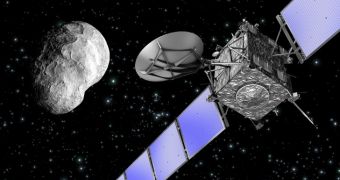This August 6, the European Space Agency (ESA) announced to the world that Rosetta, which left Earth back in March 2004, officially became the first spacecraft ever to orbit a comet.
Thus, it was this Wednesday that the spacecraft successfully caught up with its target, Comet 67P/Churyumov–Gerasimenk. Rosetta and the comet now sit at a distance of just 100 kilometers (60 miles) from one another.
On its website, the European Space Agency details that its Rosetta spacecraft and Comet 67P/Churyumov–Gerasimenk are now located some 405 million kilometers (over 251 million miles) away from our planet.
Together, they are traveling towards the inner Solar System at a speed of 55,000 kilometers per hour (approximately 34,175 miles per hour). The Rosetta spacecraft is to remain close to the comet for about a year.
“After a decade-long journey chasing its target, ESA’s Rosetta has today become the first spacecraft to rendezvous with a comet, opening a new chapter in Solar System exploration,” the European Space Agency writes in a press release.
“The comet is in an elliptical 6.5-year orbit that takes it from beyond Jupiter at its furthest point, to between the orbits of Mars and Earth at its closest to the Sun. Rosetta will accompany it for over a year as they swing around the Sun and back out towards Jupiter again,” it adds.
Scientists expect that this mission will help provide valuable information concerning the makeup of comets populating the Solar System. This information is expected to lead to a better understanding of how and why life appeared on Earth.
“Comets are considered to be primitive building blocks of the Solar System and may have helped to ‘seed’ Earth with water, perhaps even the ingredients for life,” scientists in charge of seeing to the success of this space mission say.
“But many fundamental questions about these enigmatic objects remain, and through a comprehensive,in situ study of the comet, Rosetta aims to unlock the secrets within,” they go on to explain the importance of this project.
Information obtained with the help of the Rosetta spacecraft until now indicates that Comet 67P/Churyumov–Gerasimenk is busy releasing water vapor into space at a rate of about 300 milliliters per second, the European Space Agency says.
What's more, the comet has been found to have an average temperature of about -70 degrees Celsius (-94 degrees Fahrenheit), and to display rather hectic activity patterns. Thus, over the course of six weeks, its coma was documented to become surprisingly bright and then die down.
Astronomers hope that, not too long from now, the Rosetta spacecraft will be able to get even closer to its target comet. Specifically, it is expected that the spacecraft and Comet 67P/Churyumov–Gerasimenk will come within 50 kilometers (31 miles), maybe even 30 kilometers (18.6 miles) from one another.
Should things go according to plan, the spacecraft will even attempt to send a lander to the comet. The lander, dubbed Philae, should reach 67P/Churyumov–Gerasimenk later this year, in November. Its mission will be to collect and analyze samples documenting the comet's makeup.
In a statement, Sylvain Lodiot, ESA’s Rosetta spacecraft operations manager, pointed out that, “Arriving at the comet is really only just the beginning of an even bigger adventure, with greater challenges still to come as we learn how to operate in this unchartered environment, start to orbit and, eventually, land.”

 14 DAY TRIAL //
14 DAY TRIAL //